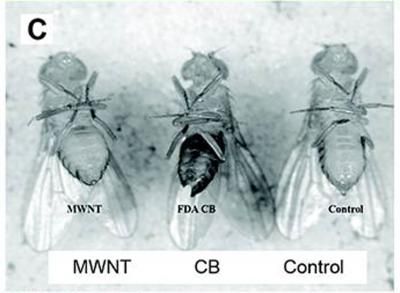New insights into health and environmental effects of carbon nanoparticles
A new study raises the possibility that flies and other insects that encounter nanomaterial "hot spots," or spills, near manufacturing facilities in the future could pick up and transport nanoparticles on their bodies, transferring the particles to other flies or habitats in the environment.

Researchers are reporting that carbon nanoparticles can be transmitted by fruit flies and that certain nanoparticles can be toxic to adult flies.
American Chemical Society
David Rand and Robert Hurt and colleagues note that emergence of a nanotechnology industry is raising concerns about the potential adverse health and environmental effects of nanoparticles. These materials show promise for use in a wide range of products, including cosmetics, pharmaceuticals, and electronics.
The study focused on determining how different kinds of exposure to nanoparticles affected larval and adult fruit flies. Scientists use fruit flies as stand-ins for humans and other animals in certain kinds of research. There were no apparent ill effects on fruit fly larvae that ate food containing high concentrations of nanoparticles. However, adult flies died or were incapacitated when their bodies were exposed to large amounts of certain nanoparticles. During the experiments, the researchers noted that contaminated flies transferred nanoparticles to other flies, and realized that such transfer could also occur between flies and humans in the future. The transfer involved very low levels of nanoparticles, which did not have adverse effects on the fruit flies. Since larvae can tolerate very high doses of nanoparticles in the diet, but adult flies show very different sensitivities, the environmental impact depends on the ecological context of nanoparticle release.
Original publication: "Differential Toxicity of Carbon Nanomaterials in Drosophila: Larval Dietary Uptake is Benign, but Adult Exposure Causes Locomotor Impairment and Mortality"; Environmental Science & Technology 2009.
Other news from the department science
These products might interest you

NANOPHOX CS by Sympatec
Particle size analysis in the nano range: Analyzing high concentrations with ease
Reliable results without time-consuming sample preparation

Eclipse by Wyatt Technology
FFF-MALS system for separation and characterization of macromolecules and nanoparticles
The latest and most innovative FFF system designed for highest usability, robustness and data quality

DynaPro Plate Reader III by Wyatt Technology
Screening of biopharmaceuticals and proteins with high-throughput dynamic light scattering (DLS)
Efficiently characterize your sample quality and stability from lead discovery to quality control

Get the chemical industry in your inbox
By submitting this form you agree that LUMITOS AG will send you the newsletter(s) selected above by email. Your data will not be passed on to third parties. Your data will be stored and processed in accordance with our data protection regulations. LUMITOS may contact you by email for the purpose of advertising or market and opinion surveys. You can revoke your consent at any time without giving reasons to LUMITOS AG, Ernst-Augustin-Str. 2, 12489 Berlin, Germany or by e-mail at revoke@lumitos.com with effect for the future. In addition, each email contains a link to unsubscribe from the corresponding newsletter.




























































